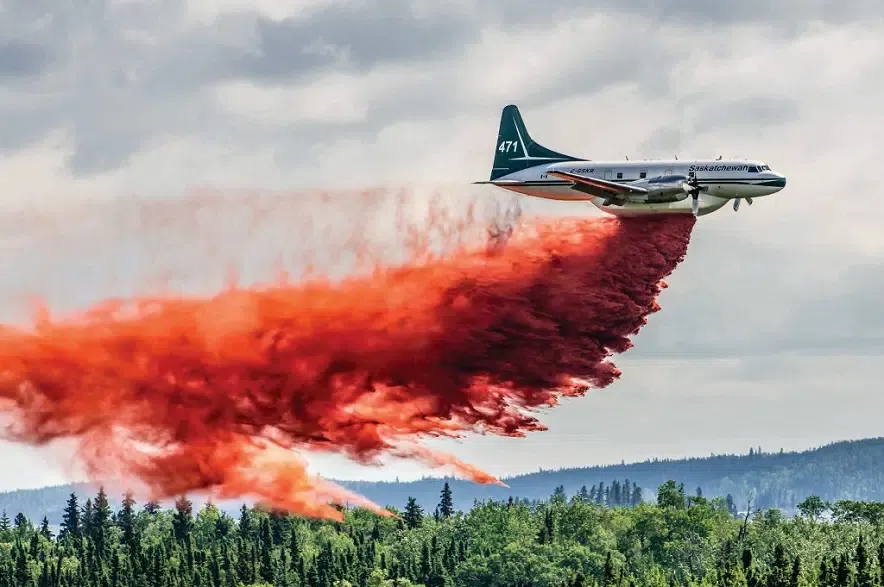The wildfire in northern Saskatchewan that forced the evacuation of Sandy Bay is still not contained, but sprinklers and other resources have been put in place to protect homes and property.
The Saskatchewan Public Safety Agency shared an update on what’s known as the Flanagan Fire on Friday morning. They are saying the blaze is less than 10 kilometres from the community. Earlier this week, the Flanagan Fire was estimated to be 130 square kilometres in size.
Sandy Bay’s roughly 1,800 residents have been forced out of the community due to the encroaching flames, and local First Nations leaders have criticized the agency’s response, saying more should have been done both ahead of and after the evacuation order was issued.
The fire breached containment lines on August 4, the agency said. It began to pose a risk not only to Sandy Bay but also to SaskPower’s Island Falls Hydroelectric Power Station.
According to the public safety agency, crews have been actively fighting the Flanagan Fire since July 10, and teams are now stationed in Sandy Bay to protect property there. In addition, an irrigation company has been hired to install high-volume sprinkler units around the community to reduce the risk even further.
“To date, no critical infrastructure has been lost due to wildfires in the province,” the agency noted in a statement.
Paul Merriman, Saskatchewan’s public safety minister, emphasized the large scale of the provincial response in the area.
“The SPSA is putting all available resources toward controlling and suppressing the Flanagan fire, which includes SPSA staff, Type 2 crews, helicopters, air tanker support, heavy equipment and fire suppression equipment,” Merriman said in a statement.
“We will continue to work with our partners and community leaders to keep our residents safe and our communities strong and vibrant.”
In the wake of the evacuation order in Sandy Bay, Peter Ballantyne Cree Nation Chief Peter Beatty said the earlier containment could have prevented the evacuation. Beatty said many trained First Nations firefighters in the area are willing to help, but claimed the agency refused to hire them due to concerns around protective equipment.
“The real issue seems to be a lack of commitment to putting out the fire, not the capability of our firefighters,” Beatty said in a statement.
“It feels like they do not want to put the fire out.”
Wildfire threatening Turnor Lake
Meanwhile, another fire – this one dubbed the LATE Fire – is burning less than five kilometres from the northern community of Turnor Lake.
That fire, which started on July 10, is also uncontained.
“The (Saskatchewan Public Safety Agency) is working in partnership with the Meadow Lake Tribal Council in supporting the communities and their residents in the area,” the agency said in a statement.
“The SPSA has been actively engaged in monitoring and suppressing the fire, as well as creating fire guards around the community of Turner Lake to protect values such as cabins. The Agency has deployed all available resources to control and suppress the fire, including SPSA staff, helicopters, air tanker support and fire suppression equipment.”
The agency said its staff will continue to engage with community leaders to keep them informed about the fires and the province’s response. According to the agency, each fire is assessed before the best way to manage it is determined. Priorities when making those determinations include protecting (in order) human life, communities, critical public infrastructure, commercial forests, and “other values.”
Fire risk remains high
As of 11 a.m. on Friday, 76 wildfires were burning in Saskatchewan, five are considered uncontained.
The province has seen 480 fires so far this year, which is well ahead of the five-year average of 331.
Earlier this week, the provincial government noted that it is expecting “above-average wildfire activity” for the remainder of the 2024 wildfire season.
“The SPSA reminds the public to avoid at-risk areas and to take all precautions to prevent new fire starts,” the agency noted.
More firefighting resources are coming to the province thanks to a joint investment which will see the provincial and federal governments each contribute $22.4 million over five years.
The money will be used to purchase equipment including radios, hoses, sprinklers and pump kits, procure and update other specialized equipment, and hire and train personnel.











